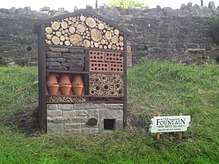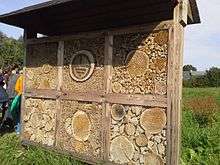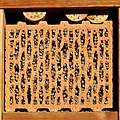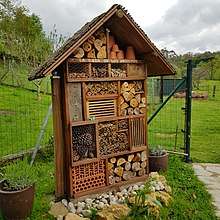Insect hotel
An insect hotel, also known as a bug hotel or insect house, is a manmade structure created to provide shelter for insects. They can come in a variety of shapes and sizes depending on the specific purpose or specific insect it is catered to. Most consist of several different sections that provide insects with nesting facilities – particularly during winter, offering shelter or refuge for many types of insects. Their purposes include hosting pollinators.

Purpose
Many insect hotels are used as nest sites by insects including solitary bees and solitary wasps. These insects drag prey to the nest where an egg is deposited. Other insects hotels are specifically designed to allow the insects to hibernate, notable examples include ladybirds (ladybugs) and, arguably, butterflies.
Insect hotels are popular amongst gardeners and fruit and vegetable growers due to their role encouraging insect pollination. Some elaborately designed insect hotels may also be attractions in their own right and, increasingly, can be found in pub gardens and various tourist locations.
Different hotels for different insects

Good materials to build insect hotels with can include using dry stone walls or old tiles. Drilled holes in the hotel materials also encourage insects to leave larvae to gestate. Therefore, different materials, such as stones and woods are recommended for a wide range and diversity of insect life. Logs and bark, and bound reeds and bamboo are also often used. The various components or sizes of holes to use as entry of an insect hotel attract different species. Ready-made insect hotels are also found at garden centers, and particularly ecological and educational conservational centers and organisations.
Solitary bees and wasps
Solitary bees, and solitary wasps do not live within a hive with a queen. There are males and females. A fertilized female makes a nest in wood or stone and bored into the wood in order to construct a nursery.
The most common bee hotel is created from a sawn wooden log or portion of a cut tree trunk in which holes are drilled of different sizes (e.g. 2, 4, 6 and 8 mm), about a few centimeters apart. They attract many bees. The holes have to be tilted slightly so that no rainwater can get in. Stone blocks are also used for this purpose. The holes are drilled quite lengthily into the material but not so far as to create a tunnel to the other side of the wood. Furthermore, the entrances to these access burrows must be smooth enough so that the delicate bodies of the insects are not damaged. Often, with wooden hotels, the exterior is sanded. The best location for a hotel is a warm and sheltered place, such as a southern-facing (in the northern hemisphere) wall or hedge. The first insects are already active towards the end of winter and would be actively seeking for such a place to settle. Other species like to furnish their nests with clay, stone and sand, or in between bricks.
Even a simple bundle of bamboo or reeds, tied or put in an old tin can and hung in a warm place, is very suitable for solitary bees. The bamboo must be cut in a specific way to allow entry for the insects. Often people may add stems of elderberry, rose or blackberry shoots whose marrow can serve as a food source as well.
Butterflies
Butterflies that hibernate like to find sheltered places such as crevices in houses and sheds, or enclosed spaces such as those in bundles of leaves. Some insect hotels incorporate special butterfly enclosures with vertical slits that take into account the animals' sensitive wings, however the suitability of these enclosures for butterflies is disputed.[1][2]
Parasitic insects
By using an insect hotel, parasitic insects are also attracted to make use of the facilities. Cuckoo bees and wasps will lay their eggs within the nests of others in order to provide them with readily available food upon hatching without the parent insect having to provide for them.
Hotels also attract predatory insects which help control unwanted bugs. For example, earwigs are good to have present in and near fruit trees as they eat the plant lice that may settle on the tree and disturb fruit growth. A terracotta flower pot hung upside-down, filled with bundles of straw or wood wool is an ideal house for earwigs. Ladybirds are easy to cater for by placing many twigs within an open wooden box on its side to provide many small cavities. Ladybirds prefer to hibernate in larger groups so this will encourage many to settle in one specific place. Isopods have their usefulness as scavengers in the garden. These animals like large gaps between stacked bricks and roof tiles to shelter from rain and to hide from predators.
Gallery
- Insect house in Pontgibaud, Puy-de-Dôme, France
 Insect hotel in the Botanical garden of Wuppertal, Germany
Insect hotel in the Botanical garden of Wuppertal, Germany- An insect hotel in a Botanical garden

 Insect hotel made from wooden pallets, at West Grinstead railway station
Insect hotel made from wooden pallets, at West Grinstead railway station

References
- Johnson, Terry W. "Out My Backdoor: Do Butterfly Boxes Work?". Out My Backdoor. GA DEPARTMENT OF NATURAL RESOURCES. Retrieved 17 December 2018.
- "How to make a butterfly house: a step by step guide". Retrieved 17 September 2019.
External links
| Wikimedia Commons has media related to Insect hotels. |
- A manual of beekeeping E.B. Wedmore ISBN 0-905652-01-0
- Royal Entomological Society
